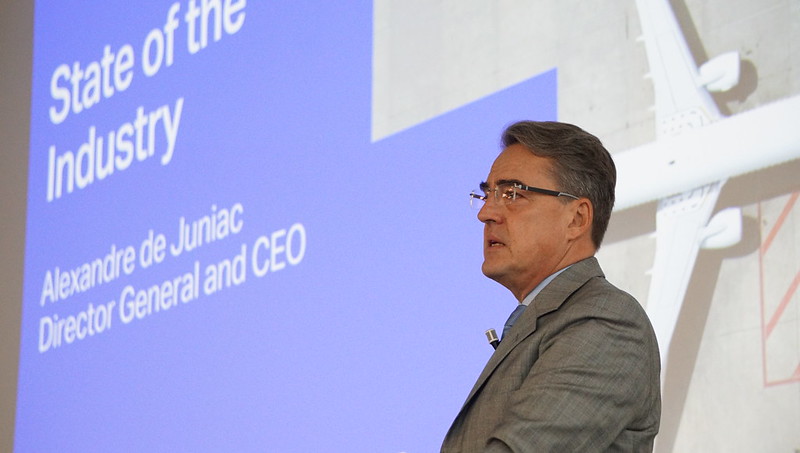
Welcome to our home in Geneva—especially to those who have traveled far. We really appreciate the great interest that media have in aviation.
Today is a special day for IATA---because we are welcoming you in our new visual identity. We are very excited about our new look which reflects the dynamism of air transport and the innovation that IATA is leading. You are the first external group to see this.
I hope that you will agree that air transport has a very compelling story to tell.
- Today 12 million travelers will be transported safely by air
- Similarly, 180,000 tonnes of cargo will be delivered by air
- Nearly three million people earn their keep by working in the industry
- About a third of global trade by value relies on air—that’s $20 billion a day
Aviation is a very relevant part of the global economy. Approximately 1% of global GDP—some $900 billion—will be spent on air travel in 2019. And that is money well spent.
In a recent IATA poll of business and leisure travelers, nearly 80% recognized the cost of travel as value for money. Indeed, the cost of travel has fallen by about 60% over the last two decades.
You may know that I call aviation the Business of Freedom. Why? Because aviation’s activity liberates people to explore, develop, trade, learn, find business opportunities and much more…essentially to live better lives.
And if you have any doubt, look at the UN’s sustainable development goals. Aviation contributes to them all—starting with the top goal of eradicating poverty. Over a billion people have been lifted from poverty through globalization. And our global world would not exist without aviation.
In the last few years the value of globalization has been questioned. This is deeply concerning. To be sure, we must aim for a more inclusive globalization. But that will not be achieved with protectionist policies or trade wars. Prosperity will come with borders that are open to people and to trade. That’s a pre-requisite for aviation to deliver its best to global economic and social development.
BREXIT is tied to this general theme. We don’t have any special insight on how this will play out. But we do know that the industry needs more clarity than we currently have.
There is no Word Trade Organization fallback for aviation in the event of a no-deal BREXIT. So it is good news that the UK is making progress on renegotiating bilateral deals with non-EU countries and that it is discussing contingency measures with the EU.
But that is only part of the story. Time-sensitive critical supplies arrive into the UK by air. So, understanding customs formalities is vital. And, as airlines are already selling tickets for the post-BREXIT period, speed in finalizing arrangements is essential.
Today
I am happy to take more questions on BREXIT later. Before we discuss the industry outlook, I would like to preview some of the topics that you will discuss today.
Safety
Safety is always the top priority. 2017 was an exceptional year with no fatalities on passenger jets. Unfortunately, with several tragic accidents, 2018 has a different narrative. Any fatality is one too many. And every accident re-dedicates all in aviation to flying even safer. Gilberto Lopez Meyer, our Senior Vice President for Safety and Flight Operations will give you a detailed briefing at the end of the day.
We keep and present annual safety statistics. But improving safety is continuous work. With the help of global standards like the IATA Operational Safety Audit (IOSA), we can be confident that flying will remain the safest form of long-distance travel.
Moreover, the same digital transformation that powered change in all industries is set to deliver a boost to our already very safe performance. You will hear later today how we are helping the industry to share data to better manage inflight turbulence. And this is only one example of the innovation that data will make possible.
Sustainability
Sustainability is critical for any industry’s future—including aviation. Effectively managing our climate change impact is aviation’s license to grow. Our focus is on coordinated action based on global standards. For example, we successfully asked governments through the International Civil Aviation Organization (ICAO) to regulate us globally to manage our carbon footprint.
The solution was the historic agreement on a Carbon Offsetting and Reduction Scheme for International Aviation (CORSIA) which will effectively cap net emissions from 2020. And by 2050 we will cut our net emissions to half 2005 levels.
I will pause here to give the floor to Michael Gill, IATA’s Director for Aviation Environment and Executive Director of the Air Transport Action Group (ATAG), to provide some details on CORSIA and aviation’s ambitious climate action.
Infrastructure
Changing topics, you will hear a lot about infrastructure today. That is for good reason. Airlines cannot connect the world without airports and air traffic management.
We are approaching an infrastructure crisis. In some locations we are already there.
Airline infrastructure needs are simply summarized as:
- Sufficient capacity
- Alignment with airline technical and service level needs, and
- Affordability
Getting these right, however, is a difficult long-term challenge. Decisions must be made today if we want infrastructure to be in place a decade from now. Our projections are for 8.2 billion air journeys in 2037 (about 4 billion more than today). And planning by most governments is not ambitious enough to meet that demand.
Air Traffic Management
The 2018 European summer was an air traffic management mess of epic proportions. Delay minutes ballooned to 14 million minutes by end October—up 53% on 2017. How long is 14 million minutes? That is 26 years! It is a completely unacceptable service record for a critical infrastructure function.
Issues with air traffic management are not confined to Europe. Congestion in the Gulf threatens the efficient functioning of their super connectors. Delays in China are rampant as demand growth outpaces the system’s capacity growth. And we see similar problems all over the world.
What do we tell governments?
The first message is that they must do better. The technical capabilities for smooth air traffic management exist. The problem is finding the political will to implement them. That can be because solutions need cross-border cooperation, because of vested interests in the controller communities or because collaboration is needed with military users of airspace.
As governments work to overcome these blockers, we have encouraged European states to build strategic national airspace plans. So far France, Spain, Bulgaria, Italy and Poland have signed agreements to develop these strategies in cooperation with IATA. And Poland and Italy are the first to deliver.
Since industry requirements are consistent from state to state, the result of these individual strategies should present a harmonized result—one that pushes toward the elusive goal of the Single European Sky.
Airports
Travelers see more directly the problems with airports. We recently polled travelers and found that 70% of them sense the overcrowding of airports. And over half would support plans to expand their community’s airport. Still, we face bottlenecks around the world.
That includes Mexico City where the new Mexican government is backtracking on constructing a critically needed hub airport. It is a shame to waste the investment already made. And it is a long-term mistake to forego the economic benefits that a major hub would generate.
Stopping a project under construction is an extreme case. But the problem of airport bottle-necks is with us in all parts of the world—Sao Paulo, New York, Frankfurt, London, Lagos, Addis Ababa, Bangkok and Sydney to name just a few.
Solving the airport capacity problem is complex.
- First, digital transformation based on global standards has tremendous potential to improve how we use airport infrastructure. Our NEXTT initiative with Airports Council International (ACI) aims to do just that. Anne Carnell will brief you on it later. You will also have a chance to speak to Andrew Price about our RFID program for baggage. And Guido Peetermans will present on One ID—an innovative program to enable passengers to get from curb to gate using biometrics.
- Second, we have a process for allocating scarce slots that need optimization. A key element is getting airports to transparently declare their capacity—something which does not happen consistently today. And we must reject calls for slot auctioning. Auctioning would enrich the airports, raise the cost of travel, provide no incentive to grow capacity, and limit competition by entrenching incumbent carriers in the airports they serve. The only long-term solution for airport capacity is to build more where it is needed. Lara Maughan will brief on why global implementation of the Worldwide Slot Guidelines is the priority until that happens.
- And lastly, airlines have many bitter disappointments with airport privatization. Our June AGM unanimously passed a resolution urging governments to be cautious. Hemant Mistry will update you on how we are working with governments to help airport privatizations to deliver on expectations by establishing best practices for concession contracts—contracts that fairly balance the interests of airports, investors, airlines, communities and, most importantly consumers.
Talent
Another critical resource that is in scarce supply is qualified people. We will need a huge number of skilled workers both for replacing retirements and to accommodate the rising demand for air travel. We saw the real impact of this when Emirates needed to trim its schedule owing to a shortage of pilots earlier this year.
The good news is that airlines are hiring. We see a 2.2% growth of the workforce in 2019 to 2.9 million employees. And that is on top of 3.1% and 3.3% growth in 2018 and 2017, respectively.
The level of participation of women in aviation is in sharp focus. The overall aviation workforce is probably roughly balanced. But that is not true at the senior level. The IATA Board of Governors is proof. Of the 32 members, two are women. And that ratio will not dramatically change because the population of women CEOs is so limited.
To help understand the blockers, we are partnering with Korn Ferry and other industry organizations in a major study. It will identify best practices from successes in recruiting, retaining and promoting women in aviation. We look forward to reporting the results of this work in the first half of 2019.
Outlook
Now let’s turn our attention towards the bottom line. While delivering the societal benefits of connectivity, it is essential that airlines are able to turn a profit, pay employees and reward investors. For much of aviation’s history that has been hard to achieve.
In the recovery from the global financial crisis that changed. Airlines have been in the black since 2010. And since 2015 we have been generating returns in excess of our costs of capital. That is a fancy way of saying that airlines are finally making a normal profit.
We don’t have a crystal ball to see what the future will bring. But we do have a Chief Economist, Brian Pearce, who will give us some insights on the financial health of air transport in 2019.
Thanks Brian. We are cautiously optimistic on 2019.
- With a 4% net margin, the first point to emphasize is that this is basically a similar performance to 2018. Given the gloom in the markets, this may be a surprise to some. But demand is strong. And we have seen a major drop in oil prices.
- The second point is that the buffer between profit and loss is thin. A dollar for a new tax, an increase in charges or shift in the oil price can eat away at the $7.75 per passenger profit very quickly. We are in a different league from Apple, for example, which makes $400 for every iPhone XS sold. Governments should not view the industry’s better financial footing as a blanket bill of health. Nor a blank check!
The aviation industry is on a more solid financial footing than at any time in its history. But to keep delivering the economic and social benefits that only aviation can, it needs a business-friendly policy framework that supports competitiveness. And you will be hearing us speak a lot about that in the coming year.
Conclusion
You have a stimulating day ahead of you, delving into interesting topics such as digital transformation, unruly passengers, new forms of payment and much more. You will see that IATA touches pretty much every aspect of the air transport sector. We hope that the topics discussed today will help with your reporting throughout the year.
I will close with a reminder of just how special aviation is.
- Economically it is a critical enabler of the global economy--supporting nearly 66 million jobs and underpinning 3.6% of global GDP with an economic impact of $2.7 trillion annually.
- And our recent polling revealed that nearly half of travelers consider air travel to be exciting—with more than a third even saying that it is glamorous.
- As I said at the beginning, for me aviation is really the business of freedom— which becomes even more meaningful as we enter this busy holiday travel period to reunite with family and friends!
As you will see today, IATA is working hard to support the success of the business of freedom with a focus on safety, efficiency and sustainability—both financial and environmental.
And now, I would like to open the floor for your questions.



